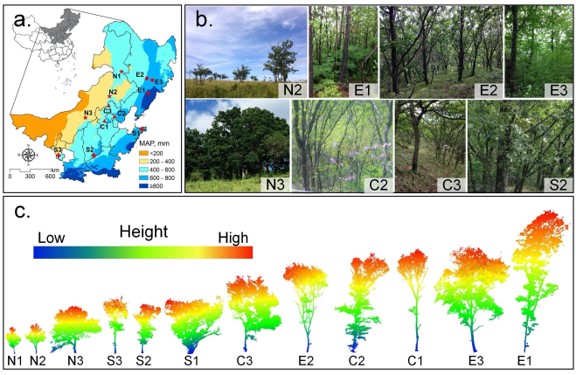Crown architecture, which is composited by an ensemble of attributes related to branch characteristics and branching pattern of a tree, is a critical component for a tree to interact with the ambient environment and to compete with neighbors.
Increasing evidences have shown that crown architecture traits play a fundamental role in the light interception process of a tree and therefore influence the subsequent carbon and water fluxes exchanged between the tree and atmosphere. Understanding the underlying processes that mediate the variability in crown architecture traits is thus an essential first step to help understand the ecological and ecophysiological responses of trees to current and future climate variabilities.
However, due to the challenge in efficiently and accurately quantifying crown architecture traits, little is known regarding how climate variability may shape crown architecture traits across large geographical extents and whether crown architecture traits have coordinated variations with trunk and leaf traits to climate gradients.
In a recent study published online in the Journal of Geophysical Research: Biogeosciences, scientists from the Institute of Botany, Chinese Academy of Sciences explored their variabilities along with environmental variability across large climate gradients in northern China, and investigated the coordinated effects between crown architecture traits and leaf traits by using Quercus (Q.) mongolica trees as an example.
They used the cutting‐edge terrestrial laser scanning technique as the tool to accurately characterize their crown architecture traits. They reported that there are significant spatial variations in trunk, crown, and leaf traits even for the same genetic group across large environmental gradients. Tree height and leaf size had tight covariations with precipitation. Tight coordinated variations were observed variations among crown architecture traits, trunk traits, leaf traits, and climate variability, highlighting there are likely fundamental evolutionary strategies regulating these covariations.
Based on these observations, they proposed the hypothesis that crown architecture have a “bridging” effect to balance the water and light demands of Q. mongolica trees. With a projected drier and hotter climate scenario in this region, these results suggest that trees are expected to transit from a “tree shape” to a “shrub shape,” with large ecological and ecophysiological impacts on the northern China.
This study provides fresh views for understanding the connections between tree structures and environmental variables, which will ultimately allow us to have a better understanding on how trees may evolve under the background of global climate change and how the coordinated effects of crown architecture traits may influence the global carbon cycling simulation.

Illustrations of the large-scale variations in Q. mongolica crown architecture across northern China.
Articlelink: https://doi.org/10.1029/2019JG005306
Contact: Email:qguo@ibcas.ac.cn
Institute of Botany, Chinese Academy of Sciences
Crown architecture, which is composited by an ensemble of attributes related to branch characteristics and branching pattern of a tree, is a critical component for a tree to interact with the ambient environment and to compete with neighbors.
Increasing evidences have shown that crown architecture traits play a fundamental role in the light interception process of a tree and therefore influence the subsequent carbon and water fluxes exchanged between the tree and atmosphere. Understanding the underlying processes that mediate the variability in crown architecture traits is thus an essential first step to help understand the ecological and ecophysiological responses of trees to current and future climate variabilities.
However, due to the challenge in efficiently and accurately quantifying crown architecture traits, little is known regarding how climate variability may shape crown architecture traits across large geographical extents and whether crown architecture traits have coordinated variations with trunk and leaf traits to climate gradients.
In a recent study published online in the Journal of Geophysical Research: Biogeosciences, scientists from the Institute of Botany, Chinese Academy of Sciences explored their variabilities along with environmental variability across large climate gradients in northern China, and investigated the coordinated effects between crown architecture traits and leaf traits by using Quercus (Q.) mongolica trees as an example.
They used the cutting‐edge terrestrial laser scanning technique as the tool to accurately characterize their crown architecture traits. They reported that there are significant spatial variations in trunk, crown, and leaf traits even for the same genetic group across large environmental gradients. Tree height and leaf size had tight covariations with precipitation. Tight coordinated variations were observed variations among crown architecture traits, trunk traits, leaf traits, and climate variability, highlighting there are likely fundamental evolutionary strategies regulating these covariations.
Based on these observations, they proposed the hypothesis that crown architecture have a “bridging” effect to balance the water and light demands of Q. mongolica trees. With a projected drier and hotter climate scenario in this region, these results suggest that trees are expected to transit from a “tree shape” to a “shrub shape,” with large ecological and ecophysiological impacts on the northern China.
This study provides fresh views for understanding the connections between tree structures and environmental variables, which will ultimately allow us to have a better understanding on how trees may evolve under the background of global climate change and how the coordinated effects of crown architecture traits may influence the global carbon cycling simulation.

Illustrations of the large-scale variations in Q. mongolica crown architecture across northern China.
Articlelink: https://doi.org/10.1029/2019JG005306
Contact: Email:qguo@ibcas.ac.cn
Institute of Botany, Chinese Academy of Sciences
